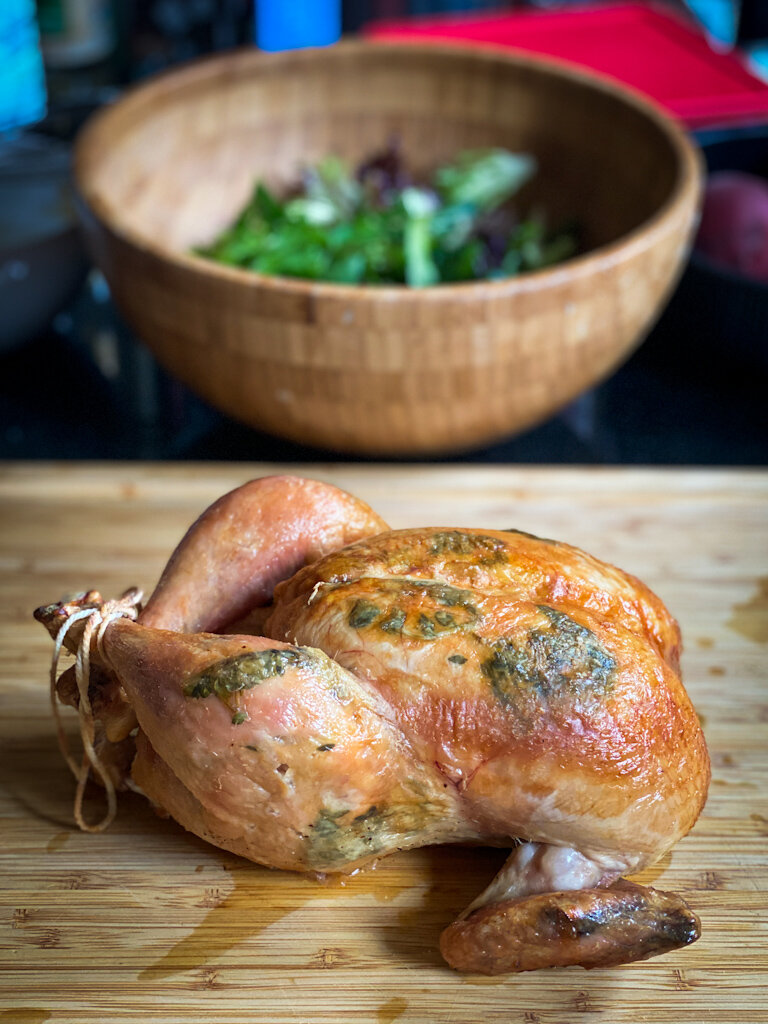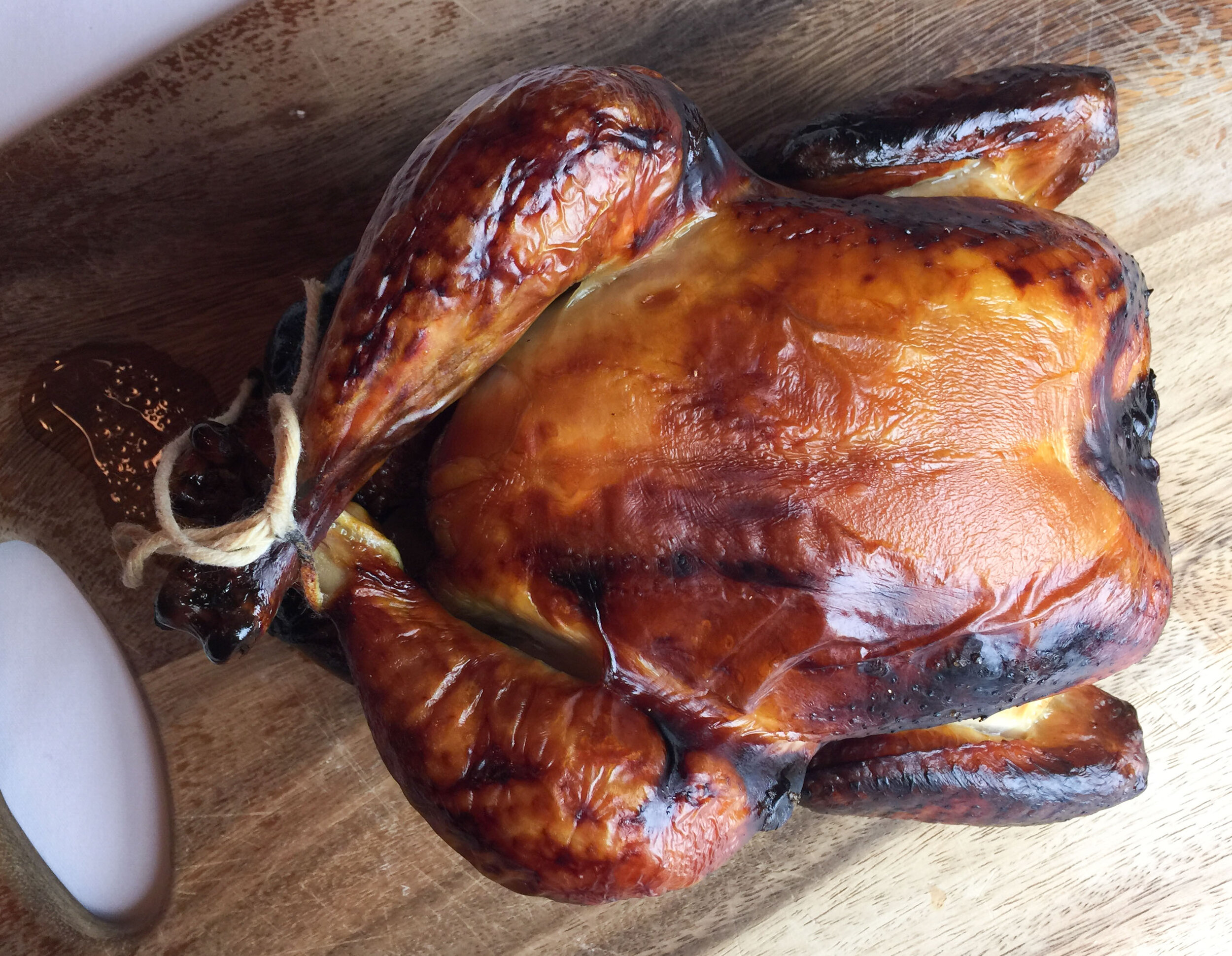Perfect easy roast chicken with crispy, brown skin. Our recipe requires no basting, no flipping and no advance preparation.
By Leslie Brenner
Yesterday was bittersweet. Wylie, my 24 year-old son and partner-in-cooking during The Great Confinement, finished packing up his silver Honda Fit, took one last look around to see what he left behind (inoperable culinary blowtorch, heavy suede jacket, melancholy parents) and — with his girlfriend Nathalie in the passenger seat — hit the road for California.
It’s a scene that’s been happening all across the country during recent weeks, apparently, as life begins to return to normal. Whatever that was.
The reasons for the bitter part of bittersweet are obvious. The sweet part is my feeling of gratefulness for the time we all had together — Wylie was with us during the entire pandemic.
I can’t exactly say that while Wylie was here I taught him to cook. That started long ago. He asked for a crepe pan for his birthday when he was, I think, seven. He spent the last year of his time in college in Los Angeles wowing his housemates with Santa Maria barbecues or giant pans of baked ziti.
But when he rejoined us a year and a half ago to regroup post-college and embark on a job search, he still had a lot to learn — as we all do. I’m pretty sure that’s when I taught him how to deglaze a pan, though he’ll probably dispute that. I definitely taught him to make corn tortillas and miso soup, soufflés and Chinese dumplings.
What I can say is that while he was here, Wylie grew up culinarily. Cooking nearly every meal during the year of confinement allowed both of us to fully immerse ourselves in the kitchen.
Of course for me there was (and always will be) plenty to learn as well. We both learned from cookbooks, videos and websites, along with conversations with cooks — Monish Gujral in India, who taught us about murgh makhani (butter chicken, which his grandfather invented); An-My Lê in New York, my brilliant photographer-friend and home cook who taught us about bánh xèo (sizzling crepes) and pho ga; Yuyee Sakpanichkul here in Dallas, the chef-owner of Ka-Tip, who talked me through the way to build a Thai curry.
What surprised me most in all this was how much I learned from Wylie. He’s a quick study, and when he wanted to master a dish, he dove headlong into it — watching chef videos, reading websites (always seeing what Kenji had to say at Serious Eats), consulting cookbooks. Most of what he wanted to learn was French (Thomas Keller became one of his faves) or meat-centric. (Kenji, in case your internet has been out for the last few years, is J. Kenji López-Alt; his fans call him Kenji.) Yet Wylie is seldom satisfied that his teachers have shown him the best way. He absorbs their wisdom, and then pushes forward, questioning assumptions, making improvements. (I suppose the apple doesn’t fall far from the tree; that constant tweaking and evolution is the animating ethos of Cooks Without Borders.)
One of the most useful things I learned from Wylie is his take on roast chicken. I had taught him everything I know on the subject, beginning with the late Judy Rodgers’ method of salting the bird a day or two before you want to roast, air-drying the skin, then tucking fresh herbs between skin and flesh and roasting simply in a skillet in a very hot oven. No need to baste, but you flip it twice. The result is an exquisite bird with wonderfully crisp skin. He tried that, tried Thomas’ Keller’s wet-brine method, which he was sure would be better (it wasn’t), tried CWB’s viral rendition of Lucky Peach’s lacquered roast chicken (impressed, but he tweaked the glaze). He tried other versions, too. We invested in a stove-top rotisserie, which makes a fabulous and very easy bird, but fixing the chicken on the rotisserie axle is a bit of a headache, and the thing can only accommodate birds smaller than three pounds, which aren’t easy to find.
After a year or so of experimenting, Wylie had settled into his preferred method. He feels salting ahead of time is best, but more often than not, when we want a roast chicken, we want it right now. One day, I suggested trying to pick up a supermarket roast chicken, something Wylie’s father and I used to do all the time when I was working at an office, and Wylie scoffed. “It’s just as easy to roast our own,” he said, “and so much better.”
Wylie’s solution to lack of time to salt and air-dry is hilarious: He pats the bird dry, sets it on a rack on a sheet pan and puts the pan on the floor with a small Vornado fan pointed at it for a half hour or so. Very effective! Then he finely chops a lot of thyme, distributes it between skin and flesh (sometimes suspended in butter), seasons inside and out, puts a whole lemon in the cavity and roasts — very simply. He uses Judy Rodgers’ basic method, heating a dry skillet on the stove, then setting the bird on it breast-up (at which point it makes a terrible loud farting sound!), and immediately putting it in a very hot oven.
Unlike Rodgers, however, Wylie doesn’t flip the bird. Rodgers’ method calls for turning it breast-down after 20 minutes, then flipping it back breast-up for the last five or ten to crisp the skin back up. Wylie doesn’t believe that there’s much (if anything) to gain with the flip, and certainly not worth the risk of the breast skin tearing in the process. He wants that perfect, crisp, browned skin.
After having eaten an adulthood’s worth of Judy birds and a year’s worth of Wylie birds, I daresay he’s right.
Last night, hours after he and Nathalie drove off, I needed roast chicken. Had Wylie been here, he would have insisted on roasting the chicken himself. Instead, I channeled him, with edits.
As I started putting it together, I realized that I finally had something I’d long been seeking: the best streamlined way to roast a chicken with minimum effort and maximum impact.
The Perfect Easy Roast Chicken, resting after its 50-minute, no-basting, no flipping stay in the oven
Busy all day, I hadn’t thought of taking the bird from the fridge and letting it come to room temp. No matter. I rinsed it and patted it dry, tucked some thyme under its skin and salted it inside and out. Pepper on the outside, too. I tied its ankles together, heated a skillet, plopped down that bird, and shoved it in the oven, set at 450. Our ridiculous smoke alarm went off three times (though the kitchen was not smoky), making us curse and miss Wylie. I pulled out the chicken and took its temperature in the thickest part of the thigh, which the experts always tell you to do: 190 degrees — overdone! How was that possible after just 40 minutes?
And then a lightbulb went off, and I finally understood that the thickest-part-of-the-thigh dictum is wrong. How many times have we pulled out the bird when thickest part registered more than 165, let it rest, carved it, and found that next to the bone, it was underdone.
So instead I inserted the thermometer next to the drumstick bone: 145. Not done. Back in went the chicken for another 10 minutes, I took the temp in the same place, and got 165.
Out came the chicken to rest — resplendent in its golden-brown skin. I made a little pan-sauce, having minced a shallot finely enough to meet Wylie’s exacting standards. (I used to be sloppier.)
I carved the bird, missing Wylie’s sharp carving knife. (He built an impressive knife collection while here.) We dined, Thierry sipping a glass of rosé, me sipping fizzy water, having reclaimed our two old accustomed places at the table for dining à deux. We toasted Wylie and Nathalie — and the adventure they’d driven off into.
And the chicken? It was perfect.














